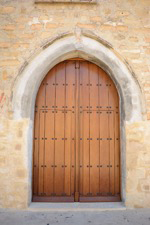
The Templar Bafomet

If we stop to contemplate the austere external ornamentation of the Church of Santa María del Alcázar, we can observe how a face carved in stone appears on one of its side facades as the only and striking decorative motif, the so-called Baphomet of Arjona.
Bafomet or Baphomet is a term originally used to describe an idol that the Templar Knights were accused of worshiping and which was later incorporated into different occult and mystical traditions.
Its symbolism is usually a head with a split beard and inclined on both sides and / or with two profiles that give rise to a front face.
The Baphomets are usually placed on the keystones of arches, whose symbolism is translated as the “support of the Church”.
In general, although they are not always located in the keystones of the arches, they are sometimes located in cornices, in angles, windows or other delicate spaces of the buildings.
The Baphomet of Arjona, of Romanesque origin due to its hieratic and rigid nature, is supported on two boards (which indicates that it was founded on the law), it is placed on the keystone of the arch of a side door of the Church of Santa María and not on the principal one.
The fact that Pope Clement V suppressed the Order of the Temple in 1312, some two hundred years before the construction of the temple, seems to indicate that the Baphomet was later embedded in the key of the door and that it belonged to a shaft or other part of a different building.
Juan Eslava Galán, an expert connoisseur of the Order of the Temple, takes advantage of the existence of the Baphomet in the Church of Santa María to incorporate it into the Templar Tombstone, as one of the main elements of interest in the plot.
(…) The Baphomet was a man’s face carved in succinct and primitive relief, rather Romanesque than Gothic, with a serious face, bulging eyes, well-combed parted beard, his hair tied back to the sides of his head like Hathor’s ancient hairstyle (…)